2022 APM 4.0 Predictions with a Review of 2021 and More
Discover how LNS Research Principal Analyst Joe Perino's predictions for 2021 stacked up and see what he predicts for APM 4.0 and more in IX for 2022.
LNS Research has long followed the open and interoperable systems movement, first in IT components and systems and now in automation systems through the initiatives of the International User Association of Automation Technology in Process Industries (NAMUR) and the Open Process Automation Forum (OPAF), of which LNS Research is an Open Group member. Both organizations have proposed standards that leverage existing standards to speed and ease adoption. The purpose of this blog is not to argue the pros and cons of the initiatives whose two groups, by the way, cooperate. Rather, we posit that:
Open, interoperable systems have a value proposition that extends well beyond the control system layer to manufacturing management and execution systems that deliver value to customers and revenue to the operating companies that serve them.
Industrial Transformation (IX) Leaders embrace these systems more than IX Followers. They understand the role of such systems in manufacturing and are better organized and focused to architect, deliver, and support them within the context of the larger manufacturing ecosystem.
First, it helps to step back and define a system. Most definitions are very similar…“a system is an organized collection of parts (or subsystems) that are highly integrated to accomplish an overall goal.” The system has various inputs, which go through certain processes to produce certain outputs, and together accomplish the overall desired goal for the system. So, a system is usually made up of many smaller systems or subsystems. And, we know that there are numerous types of systems that range from simple to complex. This definition implies that system components don’t just exchange data but interact with each other, and ideally to such an extent that, to paraphrase, “the left hand knows what the right hand is doing.” It’s important to note that we are not just talking about control systems but systems at all levels involving people, processes, technology, and cyber-physical relationships.
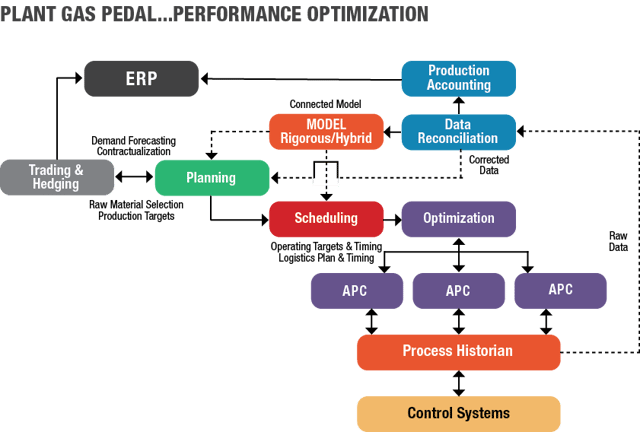
Let’s take an example from the large continuous process industry. Figure 1 above shows the relationship of a common set of applications used to drive the plant. These applications are connected by a cascading data flow which starts at planning and scheduling and flows back around after interacting with the actual plant. Are these components a system? One can argue that a software application is a system, and some of these components, once implemented, essentially run themselves. But we think the answer is no. The driver that orchestrates and holds them together is human. Second, how easy is it to obtain data from every component and analyze it to understand total performance and the dynamic interactions between the software systems and the physical operations, not to mention human actions? The answer is right now; it’s almost impossible.
We said the components in Figure 1 do not constitute a system…and in fact, the only component that is a system is the process control system. How do we systematize the components? Then, what system manages those systems? LNS Research has shown that these questions are not simply for process and process control engineers and IT to answer, though they play a vital role in doing so.
Now, we must consider systems and organization theory and design at a much larger scale, and their impact not only on operations but on the management system itself. These are questions that should raise the attention of senior management as they establish a vision for a new age of manufacturing excellence, not constrained by the number of people but by the available talent of people and the richness of systems, fully enabled by digital technologies. The answers to these questions speak to the core of a company’s business model and how they will sustain themselves in an ever-changing environment.
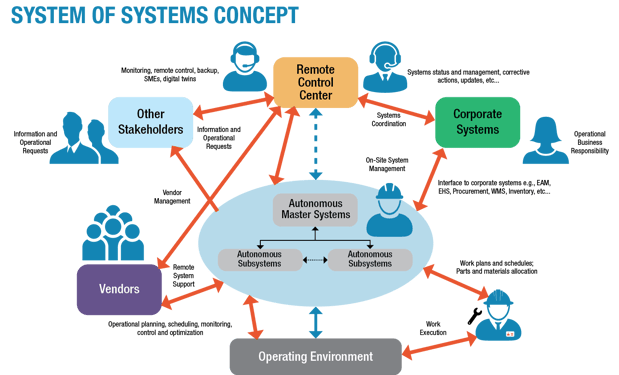
An open, interoperable system is one in which the components and protocols conform to standards independent of a particular supplier. At the control system level, there are two main approaches here, the first being the NAMUR Open Architecture (NOA) and the second being the Open Process Automation Standard (O-PAS™).
NOA wraps around and extends existing process control systems, enabling the integration of new digital technologies. The existing control system remains proprietary but opens up to support the OPC UATM protocol. This allows data to flow unidirectionally from the core proprietary systems to the IT-side systems.
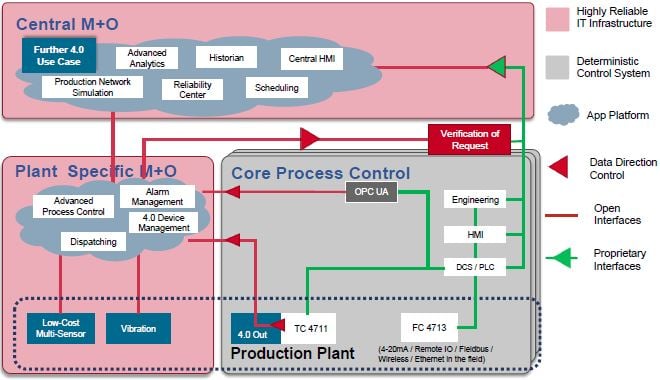
NOA NE175 says that NOA shall be open, non-proprietary, and interoperable (that is, independent of individual providers), which will be achieved by using existing open standards. To enable cross-vendor, interoperable monitoring and optimization (M+O) applications, a standardized information model needs to be defined and implemented within OPC UA, with standardized parameters and semantics. This is expected in yet to be published NE176. However, implementing an OPC UA interface does not guarantee access to all the data and functions to the M+O. This will depend on which elements of the proprietary system are exposed, if possible, to the OPC UA interface. For legacy proprietary systems, this may be a limiting factor. Not all legacy systems can accommodate an OPC UA Server.
O-PAS goes a step further. It fundamentally rearchitects the main components of the proprietary system. The idea is that one can mix, match, reuse, and upgrade components from different suppliers while still maintaining a well-functioning, reliable, and secure-by-design system. It avoids wholesale system replacement just to obtain upgraded and new capabilities. O-PAS has defined boundaries, and its interoperability is limited to conformant components. It leverages OPC UA as its communication protocol of choice and, like NOA, builds upon existing standards.
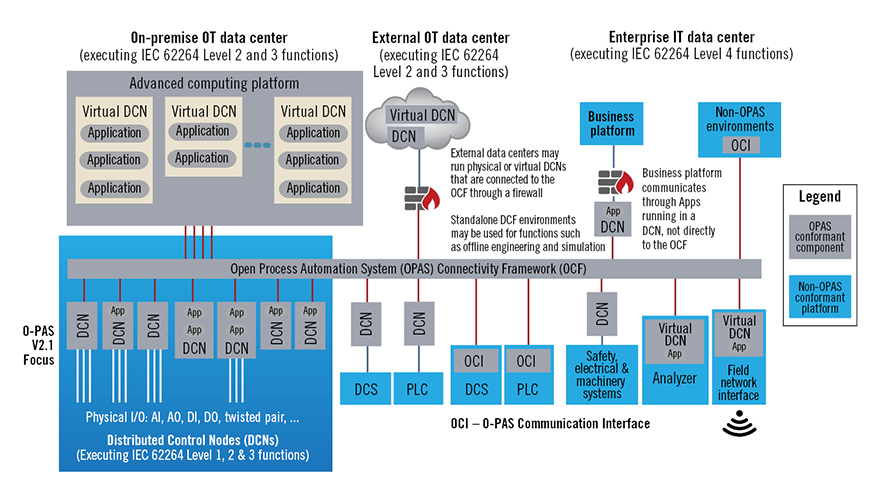
While an open system is a system that has external interactions, LNS Research would argue that a truly open and interoperable system is one that not only just exchanges data but where one system can manipulate other systems, including manipulating the subsystems of other systems. Access to system data and manipulation capability is a critically important concept as we modernize manufacturing systems and move from automation toward autonomy.
While legacy software systems can present “openness” problems, they are constantly upgraded and modernized over a few years, especially those at ISA95 Level 3. Meanwhile, control systems and other specialized control components (some of which we now call Edge devices) are not and often are expected to last 20-30 years. Thus, the immovability of proprietary control systems is the last barrier to true openness and interoperability. IT met this challenge years ago as it adopted standards, learned to deploy and support at scale, and saw its computing costs drop even as functionality and power increased.
The OPAF has published many documents that highlight five technical and cost-centric drivers for operating companies to adopt open, interoperable systems:
Imperative to improve capital efficiency by lower capital outlays and reducing lifecycle costs
Constant pressure to increase profitability from operations
Address the high cost to integrate new capabilities
Lower the high operational costs for maintenance and upgrades
Improve security, especially cybersecurity, so often bolted on and not inherent by design
LNS believes that larger business goals are facing the industry, which warrants senior management‘s attention. Thus, we would add to this list:
Manufacturing Flexibility, Agility, and Time To Value
For example, R&D produces a new reactor conversion model written in Python. Today this has to be converted to process control language deployed across multiple systems in several plants that do not all have the same control system or the same system version. With O-PAS conformant systems, the model can be rapidly deployed to one or more O-PAS components with no recoding, eliminating the potential for code errors and the need for code management.
Ditto for specialty chemical and pharmaceutical manufacturing where new products or new formulations can be flexibly deployed across a set of batch reactors for mass customization.
Talent Shortage and Upskilling
As new, younger talent is added to design and run facilities, they are not enamored with old systems that they see as dinosaurs in today’s digital world. What Millennial or GenZer wants to program in CL code? The talent challenge alone will drive upgrades, so why extend the life of the existing systems or upgrade to another closed proprietary system which no one wants to support?
Operational Excellence 4.0
LNS has written extensively about the need to redefine Operational Excellence and move from traditional continuous improvement combined with a reactive, compliance-based approach to a pro-active, innovative approach, underpinned by an integrated system, as opposed to the silo’ed 5 or 6 departmental systems that we find present in most plants. So, one might ask, what does this have to do with control systems? The answer lies in operational risk management (ORM). For example, if one asks how many control loops are in manual, why they are in manual (or were left in manual), and what impact does this have on the plant? To operational risk? Is this answer easy to obtain? We don’t think so. Do we have a solid understanding of this? Not if we cannot access the data in relative real-time and analyze it in an operational context.
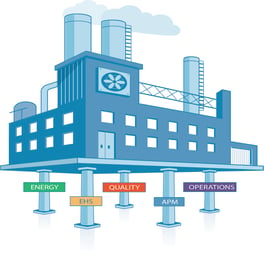
Remote Operations and Autonomous Plant
One of the COVID-19 pandemic consequences is an acceleration in the interest in remote operations and the autonomous plant. While these are not new concepts and have been done to some extent in many industries for nearly 40 years, what is new is our ability to apply digital technologies to enhance our capabilities to manage systems better. LNS’s research shows that we cannot have successful autonomous systems without open interoperability. Furthermore, Industrial Transformation (IX) will be necessary to achieve autonomous operations. Remember that autonomy is not just limited to control systems.
There are a number of reasons why the justification for open, interoperable systems often struggles to gain traction with senior management. Reasons include, but are not limited to:
If it isn’t broken, why fix it?
Ah, but it is likely broken. You may not know it, but your staff is doing a great job of “MacGyvering” to keep it running. And the cost of doing so is escalating. Management does not have to accept these legacy costs as givens. There is no need to ride the horse off the cliff and then, on the way down, hope it turns into Pegasus.
A corollary is that OT personnel often become personally attached to technologies through years of use. They also possess unique knowledge of mission critical systems and therefore exercise sufficient leverage to influence management decisions on replace and replace vs. life-extension.
We don’t have the same problem as the OPAF members.
This is true for some industries and companies, but at some point, wrap and extend solutions will not be sufficient. The old system will have to go, and then what will you do? When will “good enough” not be “good enough” for your business? Given new choices, will you repeat the past?
It’s important not to confuse standardized systems with open, interoperable systems. As was also found with IT, standardization of manufacturing systems can lead to 20% to 50% savings in the total cost of ownership, but only up to a certain point. Some operating companies excelled at automation system standardization, reaped many benefits, but then found when it was time to add new capabilities for manufacturing flexibility or simply upgrade components, they ran into the proprietary wall. Do they rip and replace, or tolerate as-is - see reason No. 1. IT beat this conundrum by standardizing on open, interoperable components, keeping both Moore’s Law and market competition working in their favor. And IT vendors learned to prosper in this new environment.
We don’t buy this digital stuff as the savior of our business.
While there are still a few doubters, they will likely end up with the Luddites, who were quickly proven wrong and disappeared in the early 19th century. Remember when DEC’s Ken Olsen said in 1977, “There is no reason anyone would want a computer in their home." Now we have them everywhere. Either you get it, or you don’t. Those who don’t will see their business suffer the consequences.
We don’t have an incentive to think beyond the next few quarters, let alone dedicate current spend to future, as yet to be defined, capital expenditures.
This is a very real issue, especially for public companies in the face of a changing environment, where sustainability and ESG are so important to corporate survival. Management must realize that openness and interoperability across their manufacturing enterprise will be enablers of sustainability, not a barrier to sustainability or a waste of capital pursuing technology for technology’s sake.
Our IT and OT people don’t see eye to eye, making it difficult to reimagine a more open and converged manufacturing environment, so we are better off leaving proprietary systems in place.
This is a challenge that nearly all companies face. But it isn’t a reason to reject new technology or open, interoperable systems. Instead, it’s both a leadership and change management challenge. LNS’s research shows that IX Leaders are almost two times as likely as IX Followers to have a converged IT/OT team engagement in IX and in supporting legacy systems. And engineering is in the mix too. LNS sees the new organizational fundamental equation of state as: IT + OT +(Engr) = T
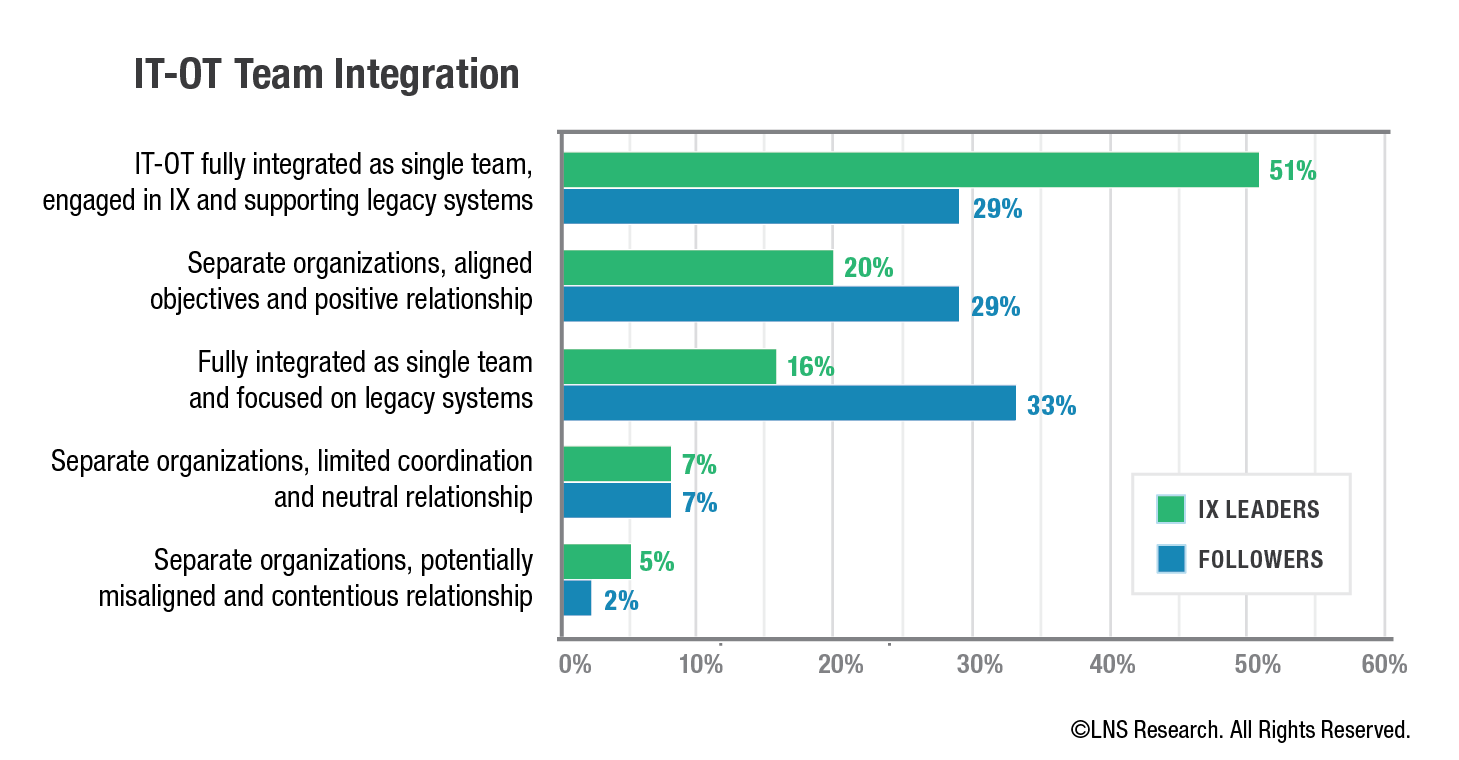 Figure 5 - IT/OT Convergence
Figure 5 - IT/OT ConvergenceWe cannot buy open, interoperable systems today.
Yes, that is true. But their availability is getting closer. As of this writing, OPAF is progressing v2.1 of its standard. LNS Research expects the preliminary version of 3.0 to become available by Q3-2022 and the final v3.0 by Q2-2023. Conformant systems should follow quickly and then mature over the rest of the decade. Once mature, the 2030s will be a period of substantial transition.
What is needed is executive commitment to have your company participate, to get your team’s nose under the tent, to contribute to its fruition and success, and then when ready, to commit your company and its capital. Realize that there is more risk in the status quo than in the constructive embracement of change. Everyone will benefit. IT did it, and so can and will OT…and this time working together.
In summary, it is important to place open, interoperable automation systems within the larger context of open systems in general and their function in the evolving process manufacturing environment. It’s time to move on from the rigid layers of the ISA 95 standard, with its air gaps and data interfaces, to the new open manufacturing ecosystem, which will encapsulate ISA 95’s layers as part of an integrated environment. This is an environment where data from all components is accessible and in which manipulatable components can be arranged in whatever way the operating company needs them – true manufacturing flexibility and agility. This will allow deviation from planned performance to be detected and corrected faster than before, translating into lower operational risk and better bottom lines. So while NOA is a step in the right direction, it ultimately does not solve the problem. O-PAS is the true step-change needed.
In short, we are at an inflection point in automation history – the same kind of inflection point that we saw when DCS’s were first introduced in the late 1970s and matured over many years to become supremely capable today. All this won’t happen tomorrow, but given our new digital capabilities and the decoupling of software from hardware, we can now progress from vision to actually building the next generation of manufacturing systems. LNS Research sees this happening at a faster rate than the last inflection point. We are confident that the technology development will keep pace. But the real question is, “Can we humans keep up? Will we be ready for cyber-physical systems, where we entrust the systems to direct us?” This is the real revolution that is coming.
As a member-level partner of LNS Research, you will receive our expert and proven Advisory Services. These exclusive benefits give your team:
Let us help you with key decisions based on our solid research methodology and vast industrial experience.
BOOK A STRATEGY CALLSiemens Acquires Camstar: Better Realizing Innovation for 3 Vertical Industries
The Definitive Guide to Manufacturing Acronyms
Five Ways Industrial AI is Shaking Up Manufacturing (and Who’s Doing It)
Top 6 Challenges in Electronics Manufacturing
What Is Industrial DataOps & Why Does Every Manufacturer Need It?
Discover how LNS Research Principal Analyst Joe Perino's predictions for 2021 stacked up and see what he predicts for APM 4.0 and more in IX for 2022.
Every year LNS Research puts forth predictions around the key trends in the Industrial Transformation (IX) topics where we focus our research. Here's...
LNS Research Analyst Joe Perino takes a look at AWS' new set of services called, “AWS for Industrial,” designed for industrial customers to innovate...
The Industrial Transformation and Operational Excellence Blog is an informal environment for our analysts to share thoughts and insights on a range of technology and business topics.